★ Semiotics, Karma and Moral Consequentialism ★ Engineering Cultural Touchstones for Mythos ★

After investing ten minutes in this article, you too can craft your own belief system that will stand the test of time. Or at least understand how “they” did it… It all has to do with semiotics.
This post discusses the principles of architecture and design as applied to semiotics and mythology to create worldview-evoking belief systems robust enough to stand the test of time. Usually, like a priceless bottle of wine, such rare knowledge requires generations of distillation.
This is…
λ ♥ (Design of Knowledge Systems)
ϕ Galvanization of Indurated Belief Systems
ϕ Weaving on the Universal Loom of Semiotics
ϕ Information Compression in Mythos
λ ♥ (Semiotic Mapping)
ϕ Accumulating Utility, While Conserving Authenticity
ϕ Survival of the Fittest
ϕ The Pragmatic Traps of Church Founding and Dragon Slaying
ϕ Significance of Semiotics to Mythology
ϕ Temporally Invariant Signs
ϕ Geographically Invariant Signs
ϕ Zero Point Energy from Lacuna Dynamo
ϕ Semiotics in Branding and Marketing
ϕ Dynamical State Machines with Ergodic Stabilization of Metastates
ϕ The Metasign Symmetry is the Most Universal Sign
λ ♥ (The Shepherd, a Universal Sign)
ϕ Jesus Was a Shepherd of Men
ϕ The Shepherd Bodhisattva in Mahayana Buddhism
λ ♥ (Semiotics of Mythology)
ϕ Tilings on the Astral Plane
ϕ And Then Jesus Turned the Water into Wine…
λ ♥ (Cultural Universals Are Semiotic Binding Points)
ϕ This Most Monumental Task of Social Engineering
ϕ Almos’ Everes’ But Never High Enough
ϕ You Haven’t Even Seen Our Final Form
ϕ A Stellar Tale of Might and Magic
ϕ Ancient Communication Protocols and Autonomous Directives
λ ♥ (Metrics of Semiotics)
ϕ The Mind Has Its Own Curse of Dimensionality: Language
ϕ Quantification of Semiotics for Statistical Methods
ϕ Zipf’s Distribution And Semiotics
ϕ Interlingual Semantic Dissonance
ϕ Humanity’s Semiotic Graph Converges Towards the Universal Semiotic Graph
ϕ Quantification of Semiotics for Statistical Methods
ϕ The Mind Has Its Own Curse of Dimensionality: Language
ϕ Quantification of Semiotics for Statistical Methods
ϕ Zipf’s Distribution And Semiotics
ϕ Interlingual Semantic Dissonance
ϕ Humanity’s Semiotic Graph Converges Towards the Universal Semiotic Graph
Remember Prometheus? Cursed to being a liver-packed bento-box meal for an Eagle. All day, every day, for eternity. Sounds super fun, right? Who wouldn’t love that?

Heads up: this article contains fire and lots of it. If Prometheus’ fate disturbs you: don’t play with fire, don’t play in the street and don’t touch Dimension W.
The Hegelian Dialectic Wins
The argument over the Hegelian and Marxist Dialectics presents itself at the center of the struggle over the metaphysical. Marxists seem to regard the metaphysical as a convenient tool, though mostly an inconvenience. That it is something to be used and tightly controlled because if people wake up to the Hegelian Dialectic, it essentially undermines atheism, which empowers institutions other than the state. Marxists have a clever joke when explaining the difference between dialectics to the uninitiated.
The Hegelian Dialetic? That’s like a form of argument where you start out trying to prove something and end up proving yourself wrong but you just keep going.
Then they show you the letter Stalin wrote in 1938, where he essentially dictated the Marxist dialectic to the USSR and acted like he was a philosopher.
The Struggle is Real
The struggle over the dialectic and it’s implications for philosophy, atheism and the meaning behind life is why studying semiotics and linguistics is so important. Signs and language are like reified metaphysical concepts that have managed to pierce through the Veil of Isis.
The struggle over the Hegelian and Marxist dialectic determines what came first: physics or metaphysics. What is the true origination of phenomena in our world? Does the metaphysical arise outside and independent of the physical? Yes? You’re a Hegelian. Is there simply not enough evidence to show otherwise? You’re probably an atheist, which is amusing because you worship science and nowhere is it more clear that phenomena arising from number theory determine the inner workings of nature in quantum mechanics. Does it feel threatening to you to find out you might be wrong and that, NO, Stalin was not a philosopher and merely dictated answers to Soviet philosophers because someone told him it’d be a convenient foundation for power and control? You’re a Marxist and I feel sorry for you, especially if you’ve given yourself over to that abusive belief system concocted by would-be tyrants.
Marxism is like the emotionally violent, drunken step-father of structuralism. Or maybe it’s the real father and the academically entangled authors of Marxism foresaw the inevitable, depressing arrival of structuralism and concocted a system of philosophy to abuse it for total state control. If you don’t know, structuralism sums up why you should fear the NSA and its panopticon, shaped like a beast with a thousand eyes and ears.
λ ♥ (Design of Knowledge Systems)
The truth is that neither the physical or metaphysical can exist independently and are cyclically interdependent for whatever reason. If one is forced to choose which is “higher” in the dependency graph of physical or metaphysical, the answer is that the physical and all of the metaphysical emerges from the cyclicly recursive kernel of the metaphysical.
That is, the whole of the universe and all the metaphysical layered on top of it emerge from math itself. If you represent this dependency graph, then you can truncate the infinite recursion with a cycle, but you you may need infinite cycles. Yes, it’s cyclical logic. Do you really care? There is no other correct answer. By Gödel’s logic, it is so decreed.
Gee, I really hope I’m not wrong about this math stuff because then I’ll just have to edit my religion

Galvanization of Indurated Belief Systems
All knowledge and information will degrade over time. Most worldly knowledge is nothing without a mind to host it. Therefore, if the system of developing/spreading knowledge doesn’t include a system of perpetuating its distribution, then it will be impermanent. The system becomes particularly vulnerable when it doesn’t include recovery mechanisms for handling distribution, dispersion, and reconstruction of knowledge. When the system can’t handle inevitable events where it’s nearly eliminated, it will almost certainly be overtaken by another belief system at some point.
i.e. if you’re one of the three little piggies, you need to build a brick house and one that can withstand anything that comes its way.
Regardless of whether the belief system is religious or secular, people need them. People prefer belief systems that accompany social institutions which exhibit strong influences on their surroundings. When a belief system retracts into fewer people, possibly due to persecution, followers are less likely to benefit from the social institutions. This not only tests your followers’ devotion, but also tests the value that your belief system has to offer if it manages to sustain itself through times like these.
On the other hand, one can design knowledge systems whose operation excels when or only when there is poor distribution and dispersion. These systems are very difficult to root out, because like the Furyans of Riddick, those who have the knowledge gain power upon its near demise. Therefore, the information economics of these systems can create incentives to perpetuate the system when it’s on its last legs.
Weaving on the Universal Loom of Semiotics
How does one become familiar with different systems of knowledge and culture perpetuation? Like Merlin and the druids of Celt, one accrues this knowledge over time, by learning to weave ideas and their semiotic pointers.
Hello. There are some who call me Tim. I’m not sure why. That’s not actually my name.

Is this a skill? Is this a kind of knowledge in itself? And if so, what is the basis of this skill of knowledge perpetuation? What are the peculiarities of such skills and systems of knowledge? How much of history are we missing, if there have always been massive incentives to keep secret the inner workings of science and world politics?
The best place to learn about this is from cultures who went underground by necessity. The Celts, the Nords and the Goths are all perfect examples of cultures whose elements and mythologies were forced underground as Christianity swept over Europe. Specifically, the Nords developed Ragnarok, one of many apocalypse myths of world culture.
The Nords, along with the rest of Europe, compromised and agreed to surpress their pagan history for a united, geopolitically defensible Europe. But what Ragnarok represents is a literal return of the pagan gods at the antipated culmination of human history thus far: overpopulation. Here, the Nords may have intentionally created this myth as an amalgamtion of other myths in an attempt to conserve what is essentially a ZIP file of their culture. The Nords intended their mythos to be unpacked and their Gods reified once more at a critical time in history.
Information Compression in Mythos
Information compression mostly works the same, whether you are compressing text encoded into tries or compressing hashmaps of some representation of data, semantic and/or semiotic. You’re basically trying to find a “folding” pattern for the data that makes it small and compressible.
The Trie Data Structure For Zipping Data and Fitting Genomic Data Into RAM
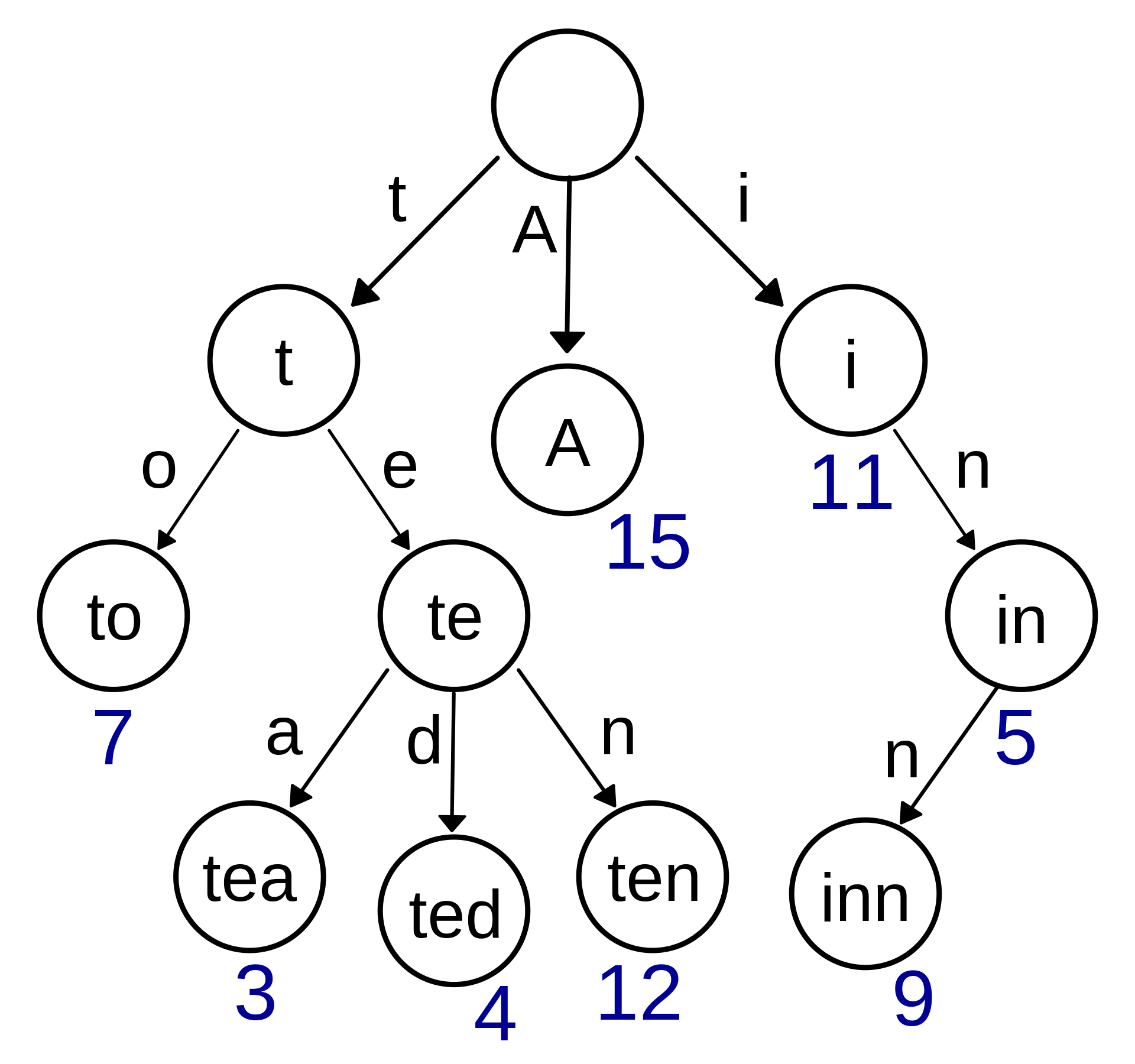
When applied to cultural mythos, this compression is advantageous: tightly-packed ideas inspire thought and study to decompress them. This required processing time and energy reinforces their longevity within the minds that host them. Compression also serves as a kind of camoflauge that protects these ideas and their functioning from competing belief systems who will assuredly attempt eradication. Light compression and obfuscation of myth also makes them more viral, more viable and more likely to survive knowledge extinction events.
Cultural Desiccation
Cultures like the Norse and the Israelis relied on myth during times of turmoil to preserve information in an encoded form. In terms of European geopolitics, they could see which way the wind was blowing: either Europe would be united through Christianity as a cultural basis or become economically subservient to the Middle East. They codified these myths in such a way as to ostensibly retain their cultural identity while compressing a set of behaviors encoded in myth, whose execution would begin upon apocalyptic events. Modernity’s forefathers deserve much more credit than we give them.
Mr. Paperclip is trying to help. How can you say no to that face?
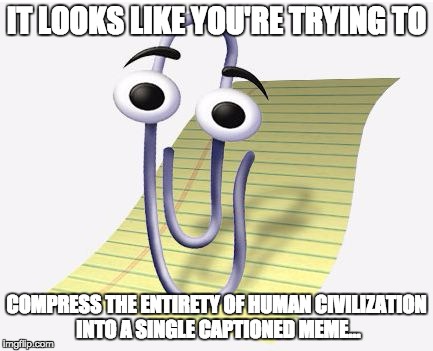
Why do some cars look like they’re smiling?
Mr Paperclip has the answer: some signifiers are deeply engrained in our brains & genetics. It’s why babies recognize human faces almost immediately. Is there something universal or simplicial about the specific structure of the human face that enables it to be encoded into our genes?
Ragnarok is perhaps the best example of a subversive attempt to use information compression for cultural preservation. It’s event-driven eschatology to be invoked upon apocalypse, whence the Gods return. The Norse priests all but disappeared, yet so long as that myth was preserved, it contained everything that would be needed to ensure the Gods return for one last battle. It was small and managed to escape Christian persecution.
I Bet Superman Could Do It
If one were to design such a system today, one that should withstand likely persecution of believers, what would one choose to preserve? Which animals would we put on the Ark? All of them, right? How would we determine what cultural elements remain truly immutable and hold true, regardless of social upheaval that acompanies the Singularity? If you took a look at the creek that became the Grand Canyon, how would you survey the land to determine the rock formations that stand the test of time, regardless of storm surge? The structure of the Grand Canyon depended little on the specifics of the events and moreso on the general nature, sequence and timing of those events.
Do you have X-Ray vision for fate?
λ ♥ (Semiotic Mapping)
In regard to references of remapped semiotics, imagine something along the lines of the following picture, but with a splash of infinity. This picture distinguishes between functions that satisfy various mapping properties, such as surjectivity and bijectivity. The whole of mathematics, even functions with continuous domains and ranges, are simply mappings.
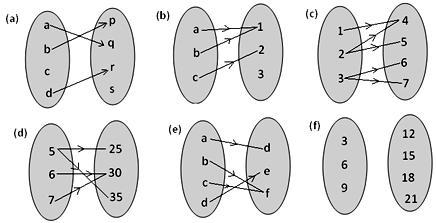
This, and other things which only seem like beautiful epiphanies to those in love with mathematics, lay in wait before you. You squander great power when you flatten phenomena and only allow them to be what they “are” and that is the essence of post-structuralism. The secret to escaping our shared structuralist nightmare is by expanding the space between languages and societies, instead of flattening culture.
Accumulating Utility, While Conserving Authenticity
How do the authors of myth abstract and obfuscate, so that the core ideas maintain authenticity? The belief system must be resillient to external subversion, manipulation and persecution. It also must maintain a degree of pliability. Because belief systems require believers to achieve significance, then flexibility is an important early factor, but this needs to be balanced with the system’s need for consistence and permanence.
Religions develop versatility of utility as they accumulate generations of knowledge. How do you anticipate when a belief system will need to change three generations from now? This is a paradox in context of many religions’ reliance on steadfastness as justification for validity of their belief system. It’s not like Jesus pitched an amendment mechanism for Christianity. How do the Singularity and modernization affect the peculiarities of religious evolution? After the Singularity, many anticipate technological stagnation, but increasing pace of change is definitely a problem beforehand. Is the next stage in humanity’s evolution finite?
Survival of the Fittest
Consider another case of our future where we instead lose the knowledge & tools to comprehend in another Dark Age. How would we update the package of myths today so that ideas remain readily consumable and relevant no matter what happens tomorrow?
Too much flexibility and you end up with offshoot organizations. While these allow the religion more flexibility and freedom, these ultimately reduce capacity for the religion’s social institutions to benefit society. There is more risk when movements branch outwards before there is enough precipitation of identity and shared culture.
The Pragmatic Traps of Church Founding and Dragon Slaying
In the design of your belief system, establishing this identity comes before you reach the pragmatic traps of founding a religion. People forget that even the most devout worshippers are human. Institutions of man are often more fallible than man itself. Pondering the pragmatic issues of founding a religion is complex, especially comprehending the ways the seven deadly sins affect viable & robust logistic structures of institions. Dealing with human nature necessitates changes to the belief systems themselves and not just the structures and processes of the institutions. The institutions must exemplify the beliefs and practices of the religion. If the followers cannot build robust institutions, your movement will fall apart. In the past, when movements started dealing with the pragmatic issues, the religion’s founder had been beyond the grave for a century or more.
Significance of Semiotics to Mythology
After learning linguistics, semiotics presents itself as another tool to quantify and analyze the structure of myth, belief and communication. As one transforms their understanding of linguistics to higher orders, it begins to sheds its relationship to language. What remains is the essence of semiotics. Therefore, semioitics is more useful than linguistics for approaching the nature of information and belief.
Semiotics involves signs composed of signifier and signified. The universiality of symbols can be observed, measured and stratified. Symbols have various degrees of universiality and whose traits vary along linguistic, semiotic and psychosocial dimensions. Understanding how a symbol’s “market” penetration, and thus utility, depends on its universiality and invariance, geographically and temporally, allows one to understand the risk/payoff for investing energy in remapping symbols.
Temporally Invariant Signs
There are temporally invariant symbols that are mostly permanent fixtures of the human condition. These symbols are signs whose signifier or signified concept can morph over time even though the pairing is mostly retained as commonly understood. Or these temporally universal symbols can be signs whose significance and meaning remains steadfast regardless of the era or age. Temporally fixed symbols are almost always geographically invariant as well: they are recognized the world over with some variance in the mapping of signifier and signified.
Temporal variance in semiotic mappings can have each linear, cyclical, generational and developmental dynamics associated with them. Especially in the context of modernization and globalization, signs across the world are undergoing constant flux in how they are mapped and in their degree of penetration. There are signs which only develop or change in significance once someone reaches a certain age and has been through specific experiences. There are signs which develop specific intergenerational dynamics. The relationships between these signs and their penetration into geographically dispersed populations offers unparalleled insight into psychosocial cultural dynamics. It begins to confer what can be perceived as God-like wisdom and intuiton.
“Religions have no value because they contain irrational information that cannot be logically demonstrated to be true.” - Some Atheist Dude
Geographically Invariant Signs
Geographically invariant symbols are also special, but can change over time, gaining or losing significance and affluence. Signs whose signifier depends heavily on the traits of local regions have a high degree of propensity for semiotic permutation, transformation and evolution as they migrate from one area to another. They are less than ideal, though useful for establishing and developing local identity. If your religion or belief system is heavily invested in mapping geographically variant signs, a central authority will lose power over them as their meaning and mapping evolves over time and space.
Zero Point Energy from Lacuna Dynamo
There are signs whose power derives from scarcity: sexual images or symbols of wealth and rare experiences. The influence derived from signs whose power is derived from a lacuna of paucity is magical. By limiting the prevelence of the signifier, you tightly control the circumstances by which the sign becomes defined in the minds of men. Therefore, you can constrain the typology of mindforms that result from exposure to the signifier. This is the power of the occult: it is power derived from the unseen. This power allows you strongly and deftfully cultivate the semiotic mappings in the mind.
Semiotics in Branding and Marketing
Signs can be used to brand an experience or brand a memory. Semiotics is incredibly powerful for branding or marketing agencies to understand, especially when these agencies understand or can manipulate/coordinate the dynamics/evolution of semiotics in the markets they develop advertisements for. Ultimately, advertising is simply paying others to influence informational mappings in the minds of consumers and it’s expensive. It’s even more expensive to change once established.
Dynamical State Machines with Ergodic Stabilization of Metastates
I’ve been working on a theory of metanomics, which describes any genomic system in terms of a probabilistically dynamical state-machine which transitions between various metastates with ergodic stablization. The true power of this paradigm for genomics is that it extends to the human mind. It is incredibly useful for artificial intelligence, but also for modeling, quantifying and predicting psychosocial cultural dynamics. In magnitude, it is the equivalent to Einstein’s insights into relativity, but for genomics, cognition and the human mind … not that anyone will ever give me a fuck’n opportunity in this world.
Imagine a dynamical system like this, but one capable of evolving to different metastates based on system behavior and capable of containerizing subsystems and state changes within regular structures like cells or nuclei.
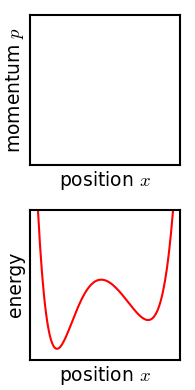
Drafts for my comprehensive theory of metanomics (These links may break)
★ Intro
★ Spatially Distributed State
★ Metaprogramming in Metanomics
The insights garnered from this perspective are beautiful. The inner workings of genomics and the human mind begin to come into focus and everything makes sense. You develop a greater appreciation for God’s work in the world. These dynamical state-machines can be designed like programs and they operate autonomously. It is a completely novel paradigm for programming. In genomics, much work as been done to put forth to develop models which stand alongside this paradigm, but none are completely able capture the behavior of all units and subunits of the system.
Yes, there are similar theories in genomics and AI, but AFAIK no paradigm of genomic programming truly accounts for the importance of containerized, spatially-distributed state and the emergence of metastates in an autonomous, probabilistic system.
The Metasign Symmetry is the Most Universal Sign
Is there a most powerful sign in semiotics, as mapped within humanity? Yes, but it’s not the instantiation of a sign. It is a higher-order metasign. It is symmetry and this is the Origin of Semiotics. Again, this implies origin in the cartesian sense as well Beginning. This origin in the “space” of semiotics also has connections to abstract algebra, number theory, galois theory, category theory and it is the unifying center of everything.
I’m studying some of the following video. I hope it will demonstrate a strong connection between the concept of origin in Number Theory, symmetry and analytic combinatorics. The video is from the Institute for Advanced Study: The Symmetry and Simplicity of the Laws of Nature and the Higgs Boson. If you’re into watching endless lectures on advanced mathematics as applied, then the Simons Institute is an unparalleled resource. I haven’t found a better mathematics self-education resource online.
λ ♥ (The Shepherd, a Universal Sign)
One thing that oneironauts must respect are other shepherds and their flocks, within and outside of oneirontology. We must respect other traditions, being especially careful not to pull their sheep away. We are a tradition whose missions include restoring general religious faith in humanity. It will not help us to pull others away from other traditions. It will only hurt us. We want to work to restore the perceived value of religion and doing so does not require evangelism. We are non-evangelistic and this tradition will not work for many people.
Jesus Was a Shepherd of Men
The shepherd is sign recognized by many religions. Jesus was a carpenter, but also a shepherd of men. The shepherd was a well known through out the middle east and other adjacent areas. Especially in Judeo-Christian traditions, the shepherd forms the basis of a partial pattern language, whereby the shepherd and the sheep in his flock become signs used to figuratively convey meaning that simple words cannot. Using metaphor enables the belief system to tightly couple itself to the core of the minds of followers in a way that pure rationalism and logic cannot.
The symbol of the shepherd is one that was universally recognized by everyone during the time of the Buddha and Jesus. As a widely-recognized sign, the shepherd was a humble role in society, where one person was entrusted with ensuring the safety and vitality of a flock. I imagine that, in most cases, this livestock was an asset that belonged to someone else.
A shepherd might operate differently in various regions, but many aspects of their responsibilities and livelihood that were shared by all cultures with agriculture & livestock. These include nearly all cultures across the globe. Therefore, by piggybacking on this sign and employing teachings to develop a specific understanding of the semiotics of a shepherd in the mind of followers, one guarentees their movement further means of universal appeal.
Regardless of the region, there are many shared traits of character and common facets to their experience. A shepherd tends to animals & livestock. A shepherd must fend off threats to the livestock. A shepherd can manage his flock to feed it well or feed it poorly. In the longterm, this can lead to a healthy flock or one that is malnourished. Today, the shepherd is also a well known symbol in several major world religions. It’s present in Judaism, in Christianity, in Buddhism, in Islam, and to a limited degree in Zoroastrianism. Why? Because all religions have, intentionally or not, piggybacked on these semiotic mappings to increase the penertrability and relevance of their content to potential followers.
The Shepherd Bodhisattva in Mahayana Buddhism
In Mahayana Buddhism, there are three degrees of bodhisattva, depending on how their actions express their beliefs. There is the king, who strives for buddhahood as soon as possible as a means of self-empowerment to help others. There is the ferryman, who strives for buddhahood, along with other sentient beings. The boatman helps watch over and guide their shared voyage, ensure that his fellow beings reach the other side. There is the shepherd, who strives for buddhahood, but only after all other sentient beings have acheived buddhahood first. The shepherd returns to the battlefield to find a new flock, lifetime after lifetime, all-but-permanently forgoing escape from the cycle of rebirth.
The shepherd is the “highest” bodhisattva, who has vowed remain behind for the longest time and make the greatest personal sacrifices. The shepherd bodhisattva essentially sacrifices their own personal attainment of buddhahood through countless lives of reincarnation.
The symbol of the shepherd is one that appears in at least four major religions. It’s not a coincidence. The sign of the shepherd is used as a basis for pattern languages, which is fueled by its universal appeal and consistent semiotic mapping.
λ ♥ (Semiotics of Mythology)
If you plan on architecting mythology for your own megalomaniacal attempt at birthing a religious movement, then dissecting the semiotics of the human condition is invaluable. Only if you truly understand semiotics before you attempt to create a religion does it ever have the hope of transcending the test of time. It is only by overlaying your belief system on top of a collection of signs temporally and geographically invariant to the human condition that it will ever stand a chance. You must architect your myths by interleaving them with this most foundational map of semiotics: the astral plane.
Check out this draft on reincarnation and the astral plane if you want to know more about Oneirontology’s understanding of reincarnation.
Tilings on the Astral Plane
How do you know what symbols to choose? Generally, universal recognition trumps everything else, but there are many universally relevant signs to weave into.
Some Examples: Water, Food, Sleep, Hunger, Greed
Emergent properties from Oneirontology’s definition of the Astral Plane should lead to antipatterns and design patterns for belief systems. Oneirontology is searching for highly resonoant consciousness crystallization.
Tilings of Polyhedra in Two Dimensions
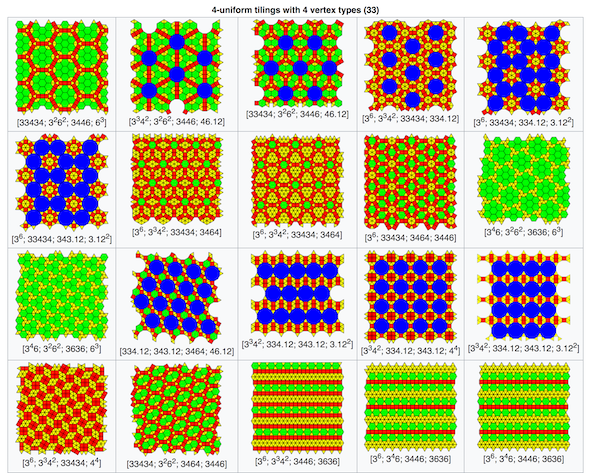
Quantifiable emergent properties of dimensionality are incredibly interesting. For example, the number of Euclidean tilings by convex regular polygons in 2D or 3D. These are metaphysically derived properties, constant and wholly emergent from mathematical primatives. Other interesting constant and emergent properties arising from the intrinsic nature of space and crystals include space groups, lattice systems, wallpaper groups and crystallographic point groups.
What are the best ways to tile these ideas in people’s heads? Is it advantageous to desire a consistent typology in your followers’ forms of belief? Or do you want the prevelance of belief-forms to varied and sporadic? There is a continuum between both. What signs and phrases key are indicative of specific belief-forms? How does one structure religious writings and practices to evoke and reinforce specific types of belief-forms? This problem is important because viable belief systems require degrees of heterogeneity in belief-forms. A completely homogenous distribution of belief-forms within followers would fail.
And Then Jesus Turned the Water into Wine…
My apologies for the religious quote out of context, but there is great power in religion’s ability to shape the minds of believers and to disregard this is to disempower oneself while disregarding psychology and sociology.
Psalm 42:1
As the deer pants for the water brooks, so pants my soul for You, O God. My soul thirsts for God, for the living God.
When Christianty and Judaism blur the spiritual and physical definitions of hunger, this is an excellent example of semiotic remapping of universal concepts. Christianity gained significant popularity at a time when poverty, hunger and the like were rampant, especially among outcasts and pariahs. When missionaries brought Christianity to a new land, the people most interested were outcasts and pariahs. The downtrodden see something in Christianity that resonates with them.
This is a great example of semiotic remapping and one that enabled the outcast Christians of the early Church to swell with pride at the sacrifices they made for their belief system. Replacing physical hunger for spiritual hunger piggybacks on the universally relevant condition of hunger. It made the early Church more likely to tolerate the hard times. Instead of being disrupted by group suffering, they used it as a means to become close. Therefore, the information that underlies the belief system must alter the believer’s understanding of signs such that negativity is transmuted into positivity.
It is unfortunate that nascent religious movements are always tempered by suffering. One might consider widespread suffering amongst early believers an injudiciously necessary alchemical cost to congealing a religion and tempering its steel. The movements that manage to survive this galvanization process will certainly stand the test of time for centuries.
I am so worried about the people who may follow me down this path. What drives me to move forward is that, in case I may be incapacitated in some way, my followers or humanity itself may have something left behind that ameliorates their suffering by giving them power through knowledge. I do not know anyone else who could ever attain the position in life that I have. Though people may accuse me of selfishly squandering what was given to me, no one can say that I did not try to stand up for those not fortified by posturing through circumstance. There are those in situations like mine who will never have the capacity to stand up and I want to ensure that I exact justice such that no one will ever fucking think twice about doing this again. I will do so peacefully and I do not care what it costs. As far as I can see, God is at my side, along with the entire world, because I cannot comprehend how I am capable of this.
A warning: there is much harm that can be done through semiotic remapping. Since it is so unpredictable and the requisite experience is almost always insufficient, great harm often accompanies even the most beneficent intentions. This is a curse of both knowledge and the illusion of control.
λ ♥ (Cultural Universals Are Semiotic Binding Points)
There is a list of about one hundred universally shared traits. These cultural universals are traits constantly available across the human condition. Though their specific mappings are not geographically invariant, their availability as mappable signifiers is universal.
There is varied degree to universal recognition. To some extent, you want those symbols to be more relevant to your own culture than to others. That is, this game is a bit like Othello, where you may find your pieces turned against you if you are not careful. We essentially all share the same set of pieces. Universally relevant symbols are useful in that they are marketable and brandable, but that trade-off is balanced by incidentally acting as additional surface area for cultural subversion.
Shakespeare Wrote a Play About My Life…

But I Didn’t Like The Ending (╯°□°)╯︵ ┻━┻) … I kid, I kid
This Most Monumental Task of Social Engineering
Which symbols will most resist semiotic change over time? That is, for both change in signifier and the mapped signified concept. These are the semiotic mappings that you can count on remaining consistent for hundreds or thousands of years. This is especially interesting, in the wake of the Singularity. It’s a paradigm shift unlike any other that blurs even the most constant ideals of the human condition: identity, time, knowledge itself, and our collective identity in the face of transhumanism. It is this precarious cultural precipice that necessitates a new belief system.
Do You Really Want This Power? Does Anyone?

Who can be trusted with this most monumental task of social engineering? Does every sufficiently advanced civilization discover what is essentially the same solution to the singularity?
Almos’ Everes’ But Never High Enough
Knowledge is power, but the gusts at this stormy pinnacle of human civilization will render us flailing in need of a belief system to grapple onto hope. Our fate is uncertain like the solution to Fermi’s paradox. I believe that there are multiple answers to the paradox, but that the positive solution to the paradox involves “dark” technology. That is, every civilization that successfully ascends does so with only a brief, centuries-long flash of electromagnetic radiation. Still, the dangers of technological ascent are real.
You Haven’t Even Seen Our Final Form

The nature of the Singularity’s changes are particularly important: is humanity embarking on a final transformation or is this a final transformation into a state of neverending exponential change? The answer to this question is particularly important for designing a belief system. If the answer is the latter option, it will prove an unfathomablely complex challenge. In this case, it’s even moreso important to nail down the points which never change, measuring their degree of unwaveringness. Only then could one hope to design a belief system to last a millenia after a transition into the perfect storm of cultural flux.
What systems of symbols will resist change in this final season of constant change? What notions of identity are constant in a world where the notion of hivemind becomes reality? What belief system gives people hope when privacy becomes a fantasy? The Singularity, the idea itself, is a powerful motivating force. A la Roko’s Basilisk, it is the idea whence power is derived.
A Stellar Tale of Might and Magic
In pursuit of understanding how humanity must prepare for the Singularity, Ragnarok presents itself as a steller example of cultural bundling and compression. Ancient people were hardly as ignorant as Westerners and atheists are led to believe early in life. Being imbued with the perception that all who came before us were helplessly ignorant is by design. This is so that society swells with pride at present accomplishments, moves unquestioningly forwards and never apologizes for the past: they were ignorant. Who knew?
“Oh look, there’s some lovely dirt over here…”

General warning in life => everyone is smart in their own way…
Our forefathers understood that once the majority of the world were literate, history would become set in stone in an unprecedented way. The understood how to operate in aeternal shadow without written language, something the far majority of people cannot comprehend today. But, because of the nature of information in the ancient world, our progenitors were very familiar with networking problems like the Byzantine Generals, though not in name. These problems are all about logistics, cost-savings in absence of information, and the minimizing the costs of failure when they are expensive. The solutions this problem are Paxos and RAFT.
Ancient Communication Protocols and Autonomous Directives
The Byzantine Generals problem is from the 20th century, but despite the name, the qualities of this and other networking solutions would be moreso valuable for societies that did not enjoy high-bandwidth communications. Therefore, they would be more familiar with architecting communication protocols and imbuing knowledge of directive-oriented solutions into their myth and magick, so that these tools would be hidden, but could be retrieved by subsequent generations. Therefore, distancing oneself from religion on the basis of rationalism and religions’ logical fallibility is disempowering. You are being deceived. Being able to relieve oneself and one’s mind of the constraints of their present epoch provides invaluable insight into the nature of reality and history, especially when such has been shielded from view.
Almost every human need, desire, norm and the perception of thus will change unrecognizably in forthcoming decades. These will diversify exponentially more than they have via modernism and post-modernism. How do we decide what to preserve? How do we preserve it in such a way that is robust and resists the potential for abuse of religion? In alignment with the values of humanism?
Theology PhD’s have written dissertations on this and similar topics. Studying apocalyptic myth like Ragnarok is eschatology, but there’s probably a more specific label for this specific study of design principles in eschatology and religion. What interests me most is the precise information compression in eschatological works. How did these people know to lay down their words in such a manner that would encode the set of beliefs to be reactivated, while enabling the belief system to persist until then?
λ ♥ (Metrics of Semiotics)
Semiotics and semantics form the basis of a Universal loom upon which all thoughts and ideas are interleaved. Semiotic graphs can emerge from linguistic analysis of communication. To hope to reach any authentic insights, one needs to analyze more than text because many concepts are hidden from purely literate communication.
The Mind Has Its Own Curse of Dimensionality: Language
To enumerate a list of mappable morphemes and underlying signifiers, a great start is the top 500 words to learn first in any language. Nearly everone’s mind is tightly coupled to language because most of us never break the mold of thinking in the language we were raised with. It’s fascinating to think that we’re all trapped in our minds and bodies, but most of us never truly learn to use them. To become familiar with this list of 500 concepts and, to force your mind to escape its binding to language, one can study sign language while simultaneously learning a new language. This forces the mind to wedge an abstraction between language and cognition. Just sign the morphemes along with verbalization of the words as you’re learning. It’s difficult to quantify, but if you can do this and you speak three languages, your IQ just jumped 20 points. Some of the most interesting tangents in linguistics involve sign language.
HIS POWER LEVEL IS OVER 200!!! (not…)
What is the solution to the Curse of Dimensionality? Does it have something to do with parameterization?
Quantification of Semiotics for Statistical Methods
There’s a law of statistics that shows up everywhere: linguistics, the size of population, network theory, etc. Distributions in nature tend to adapt themselves to this ideal Zipf distribution. Like phi and the golden ratio, it’s not entirely magic, but the distribution emerges in many circumstances because of something inplicit in their behavior.
Another interesting question relating to Zipf and linguistics is how grammatical structures and availability of function words changes the sequence and emergence of morphemes in each language’s Zipf’s distribution. For example, Japanese lacks plurals and many function words, the necessity of which is unquestionable in English. So, how does this affect the emergence of morphemes in Zipf’s distribution. This is the stuff that humanities grant applications and PhD theses are made of.
“But I have less than $2 to my name. What do I know?” - David Conner, the almost-homeless-but-not-quite philosopher
An underlying question pitched in this article: what can be crossed over from Zipf’s Distribution to the study of semiotics and cultural universals? Specifically, if such a tool exists, what is it’s utility for creating a religion? How would Oneirontology use it? Is there a single optimal way to use it?
Zipf’s Distribution on Wikipedia Articles Written in English
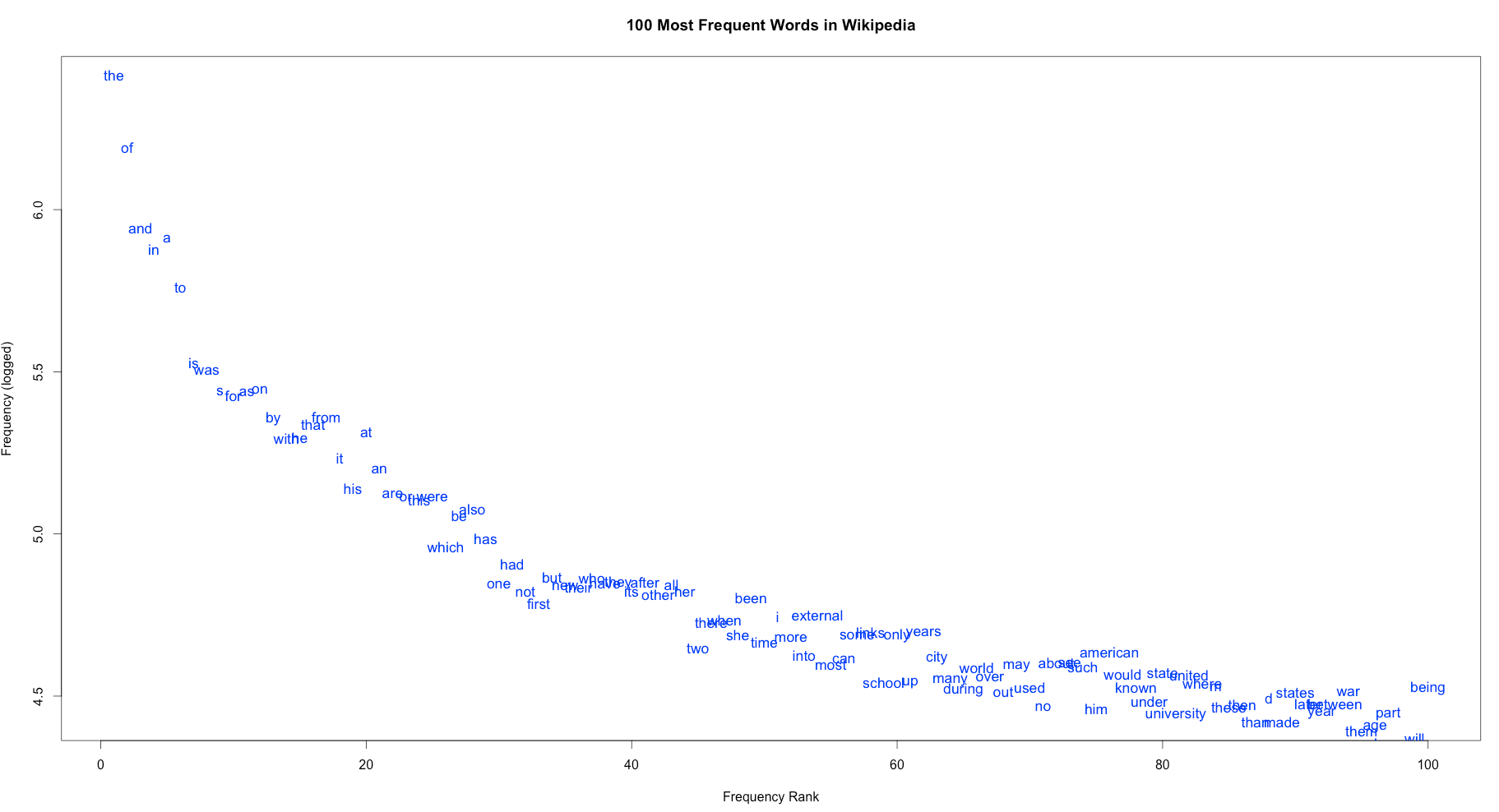
Zipf’s Distribution And Semiotics
As one recursively iterates through the infinite process of discovering more a foundational universal graphs of semiotics, understanding how and why Zipf’s law emerges should help constrain and predict the actual structure. For example, if there are missing nodes for aspects of culture humanity is too young to have discovered, their absence should be inferrable from analysis based on Zipf’s distribution. This recursive process itself has a representable structure and it should emerge within this “graph of everything.” If so, it’s location in the graph of everything should be particularly important.
Ummm, What Is “Representation Theory” …? I Wish I Knew Who To Ask
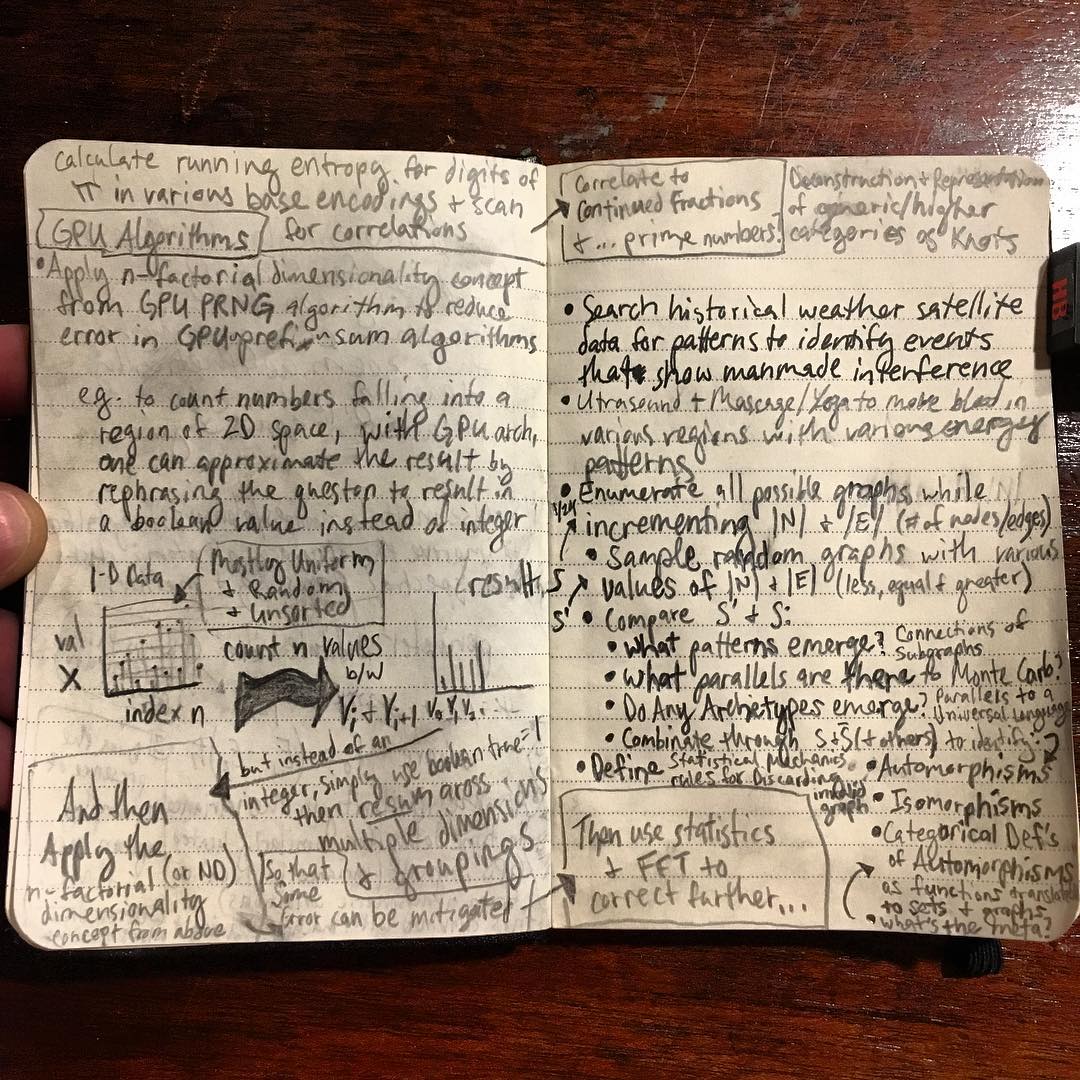
Of particular interest to myself is understanding representation of random graphs on some universal basis. These aren’t the ideas that people without college degrees usually stumble on, especially in tightly controlled isolation. For an example of a study in this domain, see Hierarchical random graph representation of handwritten characters and its application to Hangul recognition
Interlingual Semantic Dissonance
The graph below shows dissonance between semantic concepts in English and Chinese. As your analysis accomodates more languages, there should be nested graphs that emerge via recursive convergence. These should allow you to approach the asymptotically distant, foundational graph for humanity’s semiotic mappings.
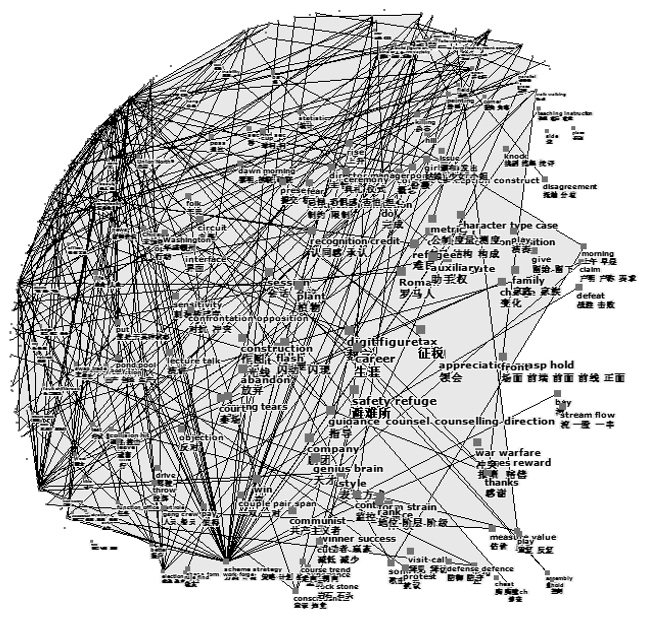
Humanity’s Semiotic Graph Converges Towards the Universal Semiotic Graph
Humanity’s semiotic graph can not account for all concepts, as many are still undeveloped. Therefore we should have a partial graph which can be mapped to the universe’s own foundational semiotic map. This convergence towards a universal semiotic graph is described in April 2016’s Polymath Post of the Year That No One Fuck’n Read: The Nature of Space, Time and Information Implies Universal Language. This post pitches slightly less than novel idea for a universal language that maps this universal semiotic network to mathematic primitives form graph theory and category, forming the basis for a language undoubted used by space aliens to communicate over vast distances without the need for a protocol to define semantics. The semantics would instead be implicit in mathematic primitives. My total annual salary in 2016: $400 … go figure.
“AMERICA! Red Robin, heart disease and NASCAR! Fuck ‘em free thinkin’ frilly philosopher types.”
Under Constant Threat of Asylum (and not the kind for political refugees)
I remember being threatened by being sent to a mental institution the morning I tried to publish the article on universal language. It’s a common theme in my life, along with constant disruption of productivity via good ole’ fashioned NSA surveillance and an NSA-augmented COINTELPRO on steroids.
That’s real cool, y’all. In response, I’ve learned to publish early and publish often. I have uploaded nearly everything I have written to Github, just in case. You have no idea how much satisfaction it brings me to write because I noticed that I finally got under Their skin, whoever They are.
AMERICA FIRST? Wut Economics
“America! Got a friend that thinks too hard?! Neurologically castrate them. Don’t talk to them. Knowledge is contagious. It’s a disease and you could get sick!” - The paradigm that powers American-led innovation in the 21st century economy…. or a subversive neo-Bolshevik attempt to sabotage the American economy.
That’s all for now. The third section of Oneirontology’s unveiling discusses specific cultural universals’ utility for the architecture of mythos.